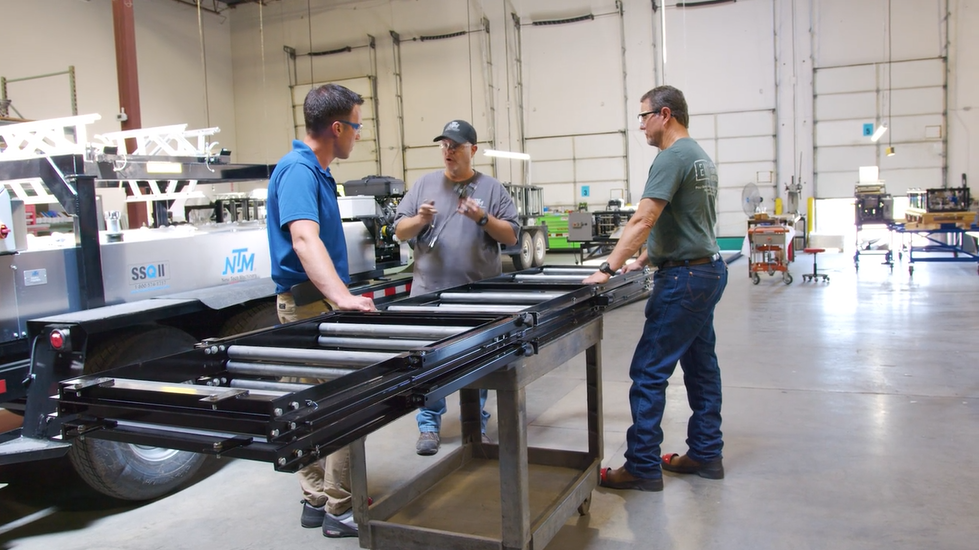New Tech Machinery (NTM) service members often receive calls about easily preventable mistakes that impact the quality of formed metal panels. In fact, machine operators can avoid many problems when running panels if they follow proper procedures. Often, when scheduling is tight, and you’re rushing from job to job, you may overlook important aspects of machine setup. In this article, you’ll learn how to avoid mistakes that impact the quality of your panels.
At NTM, we’ve helped contractors with their metal roofing, wall panel, and gutter businesses for over 30 years. We make it our mission to provide support to our customers on how to best use their machines to reach peak productivity. Part of that mission includes educating machine owners and operators on how to run panels accurately by setting up their machines correctly.

Mistake #1: Not Running Coil Through the Machine for Testing
Operators may switch profile tooling and dies but never test the machine before the job. Once you get to the job site, it’s more difficult to make adjustments and you may not have everything you need on hand, like the correct die. Plus, you don’t want to waste time if you have installers waiting on panels.
Test run the coil before you go into the field. Even if you’re not doing a profile changeover, don’t assume that because it’s the same gauge and width as the last coil used, the tooling doesn’t need to be adjusted. A difference in type of metal can be enough to require adjustments. Even another brand of the same coil size and gauge might require additional adjustments due to slight differences.
Another reason to test in-shop is to check for any issues with the coil. The width may be slightly off the defined measurement, say by a fraction of an inch. You’ll need to adjust for that. Also, you want to make sure the coil isn’t defective so you’re not showing up at the site with a coil that has inherent oil canning. Remember, each coil is different.
Also, don’t rush when changing the tooling. Take your time and get it right. The more you do it, the faster and easier it will become. However, it’s vital to get it installed correctly.
The next thing you’ll need to do is ensure that the machine is set up to the coil you’re going to run.
Mistake #2: Failing to Properly Set Up the Machine to the Coil
If you don’t properly set up the entry guide and tooling to the width of the coil, you’re going to run into problems. The width needs to be adjusted to the size of the coil so that it doesn’t slip or, if it’s too tight, doesn’t get jammed in the machine. Improper fitting can cause oil canning as well. Be sure to properly set up the entry guide and tooling to the exact width of your coil. Next, let’s look at making sure that the coil arbor is aligned with the machine.
Mistake #3: Not Aligning Coils with the Machine
Whether you’re using an overhead or free-standing arbor, position the coil straight, aligned to the machine. Otherwise, it won’t run through correctly, and your panels will show oil canning, camber, or taper. Also, make sure the reel is set in the correct position and the nut on the correct side. Doing this every time will help ensure that you don’t run into problems in the field that may be hard to diagnose given the number of variables. This leads us to look at a bad habit that’s easy to fall into—tinkering with the machine.
Mistake #4: Tinkering With the Rollformer
For many of us, referring to the user’s manual is a little like pulling over to ask directions. We want to feel we can figure it out on our own. However, you can damage your machine by trying to make adjustments through experimentation. This can end up costing money in parts and labor to undo the damage, not to mention lost productivity while the machine is down. Consult your user’s manual or reach out to an NTM service representative or your distributor if you’re having trouble locating the cause of a problem. Another bad tinkering habit relates to recalibration, which we’ll look at next.

Mistake #5: Over-Calibrating with Manual Calibration
Some operators take it upon themselves to calibrate using manual calibration on the controller, only to wind up making the wrong adjustments. If you calibrate the machine manually, you’re changing the diameter of the encoder setting, which you don’t want to do. If every panel you run is consistently off, then you may need to calibrate manually.
Keep in mind, your controller is designed to calibrate automatically. If you run five or six pieces, the controller will automatically analyze and adjust accordingly as it runs. Also, you may need to allow it to recalibrate more than once. For example, if you’ve moved the machine from its original location, or if you’re starting it in the morning after a cold night you may need to run some pieces for your rollformer to recalibrate automatically. You can also consult your help screen for information. If you are having a problem with automatic calibration and you think you need to set it manually, first contact our service department or your distributor. Another common problem is failing to align the shear, which we’ll look at next.
Mistake #6: Failing to Follow Shear Alignment Procedures
Make sure to follow the proper procedures in aligning your shear dies and shear blade. The user’s manual explains the proper procedures for shear alignment. Make sure when you change the profile you also change the dies. Misalignment can jam the coil, scratch the panel, or cause bowing, and won’t run the panels correctly if the wrong dies are in place. Another factor that can compromise panel quality is a trailer that isn’t sitting level.
Mistake #7: Not Leveling the Trailer from Side to Side
Sometimes you may have the trailer parked on a hill so that it’s sloped, which is fine. What you want to be sure of is that it is level from side to side. Otherwise, your panels could come out with some uphill or downhill camber due to the gravitational pull as the machine is leaning to one side. Balance and alignment are key to fabricating quality panels. This includes run-out stands.

Mistake #8: Not aligning the rollformer with the run-out stands
The run-out stands must be parallel to the machine. Otherwise, your panels may run with an uphill or downhill camber. The rollformer and run-out stands must be parallel to run straight panels.
Mistake #9: Neglecting Machine Maintenance
The shear blade should be lubricated daily and frequently while producing panels. Clean the drive rollers regularly. Grease the chains, change the oil in the gas motor regularly and the hydraulic fluid and filter annually. Keep a regular maintenance schedule to make sure your rollformer is running at optimal capacity. Your NTM machine should continue smooth operation for many years if you take proper care of it. It’s easy to learn how to maintain your machine if you’ve had the proper training, which is our last common mistake.
Mistake #10: Skipping NTM Machine Training
Proper training will go a long way in helping you avoid the types of mistakes we’ve just looked at. Every new machine owner is eligible for free in-plant training at our facility in Aurora, Colorado. We recommend that you bring along anyone who will be operating your machine. That way, each one of you will be well educated on the functions of the machine, making adjustments, operating the controller, using different types of materials, and maintaining the rollforming equipment.
Training can also be done on-site for an additional fee.

But All of This Takes Too Much Time!
Imagine it’s one of those mornings when you have an early job. There’s just enough time to get to the plant, pour a coffee, and get your machine out to the site. You glance over the machine, and everything looks good—the trailer is hooked up, and the right profile tooling is installed. But when you get to the job site, the panels aren’t running straight. There’s camber or oil canning, but you can’t figure out what you missed in setting up the machine. Then you start tinkering, and things only get worse.
While proper training, running test coil, aligning the shear, etc., sounds time consuming, in the long run, you’ll save time and better streamline your operation by not spending hours fixing mistakes or making adjustments on the fly.
We encourage you to check out our how-to videos and articles on our Learning Center and YouTube channel. We also post to social media, so be sure to follow us on Facebook, LinkedIn, Instagram, and X (formerly Twitter) for the latest rollforming content.
To learn more about NTM metal rollformers and gutter machines and how NTM can help your metal roof, wall panel, or gutter operation, contact one of our account managers. For any issues with your current machine, contact our service department.

